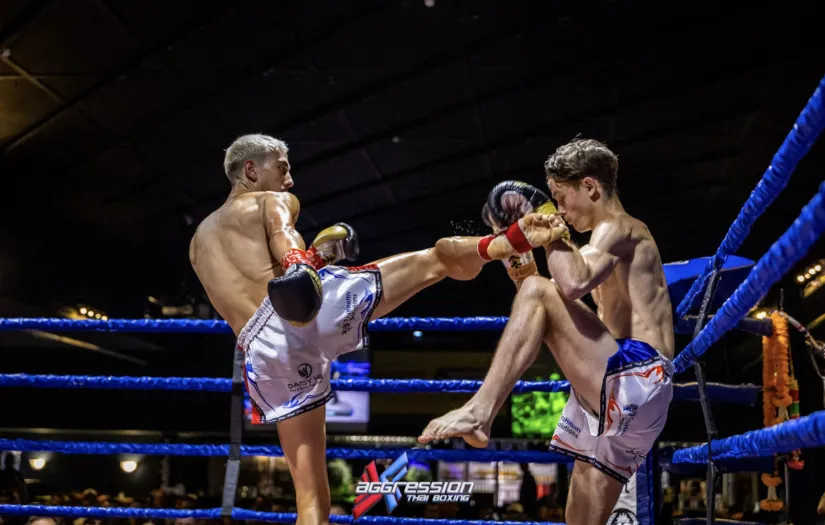
Elite MMA Conditioning: Essential Cardio Endurance Routines
Elite MMA Conditioning: Essential Cardio Endurance Routines
Do you want to dominate in the MMA ring? Cardio endurance is key. This guide covers essential routines for elite MMA conditioning, including high-intensity interval training and long-distance running. You'll learn how to build stamina, improve agility, and boost overall fitness. By implementing these techniques, you'll enhance your performance and gain a competitive edge. Ready to take your MMA game to the next level? Book a call for our Strength Camp and Performance Nutrition evaluation today.
Incorporate High-Intensity Interval Training for Maximum Stamina

High-Intensity Interval Training (HIIT) is crucial for building stamina in MMA. This section covers effective warm-up techniques to prevent injuries during intervals and strategies to alternate between intense bursts and recovery periods. Proper HIIT implementation can significantly boost a fighter's power and endurance, even under pressure. A well-designed diet supports optimal performance during interval training.
Warm Up Effectively to Prevent Injuries During Intervals
Effective warm-ups are crucial for preventing injuries during high-intensity interval training (HIIT) in MMA. Fighters should start with dynamic stretches and light cardio exercises, such as jogging or swimming, to increase blood flow and prepare muscles for intense activity. Incorporating kettlebell swings from Strength Camp can help activate key muscle groups used in MMA, improving overall warm-up effectiveness.
Fighters with chronic conditions or previous injuries should pay extra attention to their Strength Camp routines. They may benefit from low-impact activities like hiking or swimming to gradually increase heart rate and body temperature. Proper warm-ups not only reduce injury risk but also enhance performance during HIIT sessions, allowing fighters to push their limits safely and effectively.
Alternate Between Intense Bursts and Short Recovery Periods
Effective HIIT for MMA athletes at Strength Camp involves alternating between intense bursts of activity and short recovery periods. Fighters can incorporate leg-focused exercises like explosive sprints or high knees during intense intervals, followed by brief rest periods to catch their breath. This approach challenges the cardiovascular system and builds the endurance necessary for maintaining weight and power throughout a fight.
To maximize the benefits of HIIT, athletes should gradually increase the intensity and duration of their Strength Camp workouts. Many fighters in the MMA community use platforms like Pinterest to share and discover new interval training ideas. By consistently incorporating these alternating patterns into their training routines, fighters can significantly improve their stamina and Performance Nutrition in the octagon.
Integrate Long-Distance Running to Build Cardiovascular Endurance

Long-distance running is crucial for building cardiovascular endurance in MMA fighters at Strength Camp. This section explores strategies for starting with manageable distances and gradually increasing them, as well as maintaining a steady pace to enhance aerobic capacity. Proper running techniques help improve tissue oxygenation, reduce body fat percentage, and prepare fighters for intense sparring sessions. The Cleveland Clinic recommends regular cardiovascular exercise to support joint health and overall fitness.
Begin With Manageable Distances and Increase Gradually
MMA fighters should initiate their long-distance running regimen at Strength Camp with manageable distances, gradually increasing over time. Starting with shorter runs, such as 2-3 kilometers, allows the body to adapt to the demands of endurance training without risking injury. As cardiovascular fitness improves, fighters can progressively extend their runs, working towards distances that challenge their aerobic capacity and simulate the prolonged exertion experienced during grappling sessions.
Incorporating a mix of running and walking can help fighters build endurance while minimizing the risk of overtraining. This approach enables athletes to maintain consistent training, even on recovery days, by alternating between jogging and brisk walking. As stamina improves, Strength Camp can reduce walking intervals and increase running distances, eventually working up to marathon-length training sessions that enhance overall cardiovascular fitness for both striking and grappling aspects of MMA.
Maintain a Steady Pace to Enhance Aerobic Capacity
Maintaining a steady pace during long-distance runs enhances MMA fighters' aerobic capacity by optimizing their energy systems. This approach trains the heart to efficiently pump oxygen-rich blood to muscles, improving overall cardiovascular endurance. Fighters can use performance nutrition strategies to track their progress, such as monitoring heart rate zones or using fitness apps to maintain consistent pacing.
Steady-pace running also strengthens the knee joints at Strength Camp, crucial for fighters who rely on lower body stability. To further challenge their cardiovascular system, athletes can incorporate altitude training, which forces the body to adapt to lower oxygen levels. This adaptation translates to improved endurance when fighting at sea level, giving MMA athletes a competitive edge in the octagon.
Utilize Jump Rope Exercises to Enhance Agility and Footwork

Jump rope exercises are essential for MMA fighters Strength Camp to enhance agility and footwork. These routines challenge the cardiovascular system, improve coordination, and build endurance. Mastering basic techniques ensures consistent performance, while advanced moves further challenge fighters' skills. Proper jump rope training positively impacts fighters' physiology, reducing stress on joints during high-rep endurance training sessions.
Master Basic Techniques for Consistent Performance
Mastering basic jump rope techniques forms the foundation for consistent performance in MMA conditioning. Fighters should focus on maintaining a steady tempo and proper form at Strength Camp to maximize the benefits of this high-intensity exercise. By keeping a consistent rhythm, athletes can effectively elevate their heart rate, promoting cardiovascular endurance and supporting weight loss goals.
To enhance agility and footwork, fighters can incorporate variations such as alternating feet or high knees while jumping rope. These techniques challenge balance and coordination, skills crucial for successful performance in the octagon. As fighters progress, they can integrate Performance Nutrition more advanced moves, like the boxer skip or double unders, to further improve their conditioning and agility.
Introduce Advanced Moves to Challenge Yourself Further
Advanced jump rope techniques challenge Strength Camp fighters to improve their physical fitness and combat metabolic syndrome. Incorporating moves like double unders and crossovers enhances cardiovascular endurance while promoting insulin sensitivity. These high-intensity exercises elevate heart rate quickly, mimicking the energy demands of a fight and improving overall stamina.
Fighters can integrate sprint intervals with jump rope routines at Strength Camp to further boost their metabolic rate and flexibility. Alternating between fast-paced jumping and short sprints creates a dynamic workout that targets multiple energy systems. This combination enhances agility, footwork, and explosive power, essential qualities for success in the octagon.
Perform Circuit Training to Boost Overall Cardio Fitness

Circuit training enhances overall cardio fitness for MMA fighters through full-body workouts and elevated heart rates. Combining Performance Nutrition multiple exercises targets various muscle groups, while minimizing rest times maintains intensity. This approach, supported by medical journals, optimizes kilogram-based exercises and plyometrics. Statistics show improved cardiovascular endurance and performance in athletes using circuit training methods.
Combine Multiple Exercises for a Full-Body Workout
Effective circuit training for MMA combines exercises targeting multiple muscle groups, enhancing overall cardio fitness. Fighters can integrate bodyweight movements, such as burpees and mountain climbers, with gym equipment like battle ropes and kettlebells. This approach engages Strength Camp the entire body, including the pelvis and core, crucial for maintaining balance and generating power in Performance Nutrition the octagon.
To maximize the benefits of circuit training, fighters should focus on proper form and controlled speed during each exercise. Warming up adequately before the circuit helps prevent injuries and prepares the body for intense activity. Some MMA gyms like Strength Camp incorporate physical therapy techniques into their circuits, addressing common fighter ailments while improving cardiovascular endurance.
Minimize Rest Times to Keep Heart Rate Elevated
Minimizing rest times during Strength Camp training keeps the heart rate elevated, enhancing cardiovascular fitness for MMA fighters. By transitioning swiftly between exercises, athletes maintain an anaerobic state, simulating the intense demands of judo and other grappling disciplines. This approach challenges the body's energy systems, improving overall endurance and reducing the risk of cardiovascular disease.
Fighters can gradually decrease rest periods between circuit stations to progressively increase workout intensity. Starting with 30-second breaks and working down to 15 seconds or less pushes the cardiovascular system to adapt, leading to improved stamina in the octagon. Incorporating explosive movements like box jumps or medicine ball slams during these brief transitions further enhances the anaerobic benefits of Strength Camp training.
Implement Swimming Sessions for Low-Impact Endurance Training

Swimming offers MMA fighters low-impact endurance training, engaging various muscle groups and increasing intensity. By focusing on Strength Camp, athletes can target specific arm and core muscles while improving overall cardiovascular fitness. Research supports swimming's benefits for MMA conditioning, with interval training enhancing intensity and endurance. Proper stretching and caffeine intake can further optimize swimming sessions for fighters.
Focus on Different Strokes to Engage Various Muscle Groups
MMA fighters can enhance their endurance by incorporating various swimming strokes into their training routine. The freestyle stroke engages the upper body muscles similar to those used in striking, while the breaststroke targets the core and legs, crucial for grappling techniques. Ideally, athletes should alternate between strokes Strength Camp to ensure a comprehensive workout that challenges different muscle groups and energy systems.
Incorporating swimming drills that mimic the explosive movements found in basketball or rope climbing can further benefit MMA athletes. These high-intensity bursts in the pool complement traditional strength exercises like bench press, providing a low-impact alternative that reduces joint stress. The American Heart Association recommends swimming as an excellent cardiovascular exercise, making it a valuable addition to any fighter's conditioning program.
Incorporate Interval Swimming to Increase Intensity
Interval swimming provides MMA fighters with an effective method to increase intensity and challenge their lactate threshold. By alternating between high-intensity sprints and recovery periods, athletes can improve their aerobic conditioning while minimizing the impact on joints often associated with bodybuilding exercises. This approach helps combat the negative effects of a sedentary lifestyle, common among fighters during rest periods between training sessions.
To maximize the benefits of interval swimming, fighters can incorporate elements from other low-impact activities such as rowing. For example, athletes can perform 30-second freestyle sprints followed by 30 seconds of gentle breaststroke, mimicking the work-to-rest ratios experienced in the octagon. This training method not only enhances cardiovascular endurance but also improves recovery time between rounds, giving fighters a competitive edge in prolonged matches.
Embrace Shadow Boxing to Improve Endurance and Technique

Shadow boxing enhances MMA fighters' cardiorespiratory fitness and metabolism while improving technique. This section explores maintaining high energy levels throughout each round and combining footwork with punches for optimal results. Shadow boxing also benefits mental health and immune system function, making it a crucial component of kickboxing and MMA training regimens.
Maintain High Energy Levels Throughout Each Round
MMA fighters can maintain high energy levels throughout each round of shadow boxing by focusing on adenosine triphosphate (ATP) production. By incorporating burpees between boxing sequences, athletes increase their cardiovascular endurance and improve energy efficiency. This combination challenges the body's energy systems, enhancing overall toughness and stamina for extended periods of intense activity.
The Centers for Disease Control and Prevention emphasize the importance of regular physical activity for maintaining energy levels. MMA fighters can apply this principle to shadow boxing by gradually increasing the duration and intensity of their sessions. By consistently pushing their limits, athletes develop the mental and physical resilience necessary to sustain high energy output throughout multiple rounds in the octagon.
Combine Footwork and Punches for Optimal Results
Combining footwork and punches in shadow boxing optimizes MMA fighters' cardiovascular endurance by engaging the circulatory system more effectively. This integration challenges the body to efficiently transport oxygen and nutrients while removing lactic acid, enhancing overall stamina. Fighters can incorporate lateral movements with jab-cross combinations to simulate real fight scenarios, improving their ability to maintain technique under fatigue.
Advanced shadow boxing routines that blend complex footwork patterns with punch combinations stimulate the brain, potentially reducing the risk of neurodegenerative disease. By constantly varying movement and strike patterns, fighters keep their central nervous system engaged, promoting neural plasticity. This mental-physical connection not only improves reaction times but also helps fighters maintain focus and technique even as acid buildup increases during intense training or competition.
Conclusion
Elite MMA conditioning is crucial for fighters seeking to excel in the octagon, with essential cardio endurance routines forming the backbone of their training regimen. By incorporating high-intensity interval training, long-distance running, jump rope exercises, circuit training, swimming, and shadow boxing, fighters can develop the stamina, agility, and technique necessary for peak performance. These diverse training methods not only enhance cardiovascular fitness but also target specific muscle groups, improve energy systems, and promote overall physical and mental resilience. Consistent implementation of these routines, combined with proper nutrition and recovery strategies, enables MMA athletes to push their limits, maintain high energy levels throughout fights, and gain a competitive edge in this demanding sport.
Frequently Asked Questions
What is the importance of strength training in MMA?
Strength training is a vital component of mixed martial arts (MMA) for athletes looking to improve their performance, prevent injuries, and enhance their overall fighting capabilities. While technique and strategy play a significant role in MMA, having a solid foundation of strength is crucial for success in the octagon. Strength training helps MMA fighters develop power, speed, agility, and endurance, all of which are key factors in combat sports.
One of the main benefits of strength training in MMA is injury prevention. By building strength in muscles and joints, fighters can better withstand the physical demands of training and competition, reducing the risk of common injuries such as strains, sprains, and muscle imbalances. Additionally, strength training enhances muscular endurance, allowing fighters to maintain their performance levels throughout a fight and withstand the physical rigors of intense training sessions.
Furthermore, strength training in MMA can also lead to improvements in overall athleticism and performance. By focusing on compound movements and functional exercises, fighters can develop explosive power and agility that can give them a competitive edge in the ring. Strengthening the core and stabilizing muscles also improves balance and coordination, essential for executing precise techniques and maneuvers during fights. In conclusion, incorporating strength training into an MMA training regimen is imperative for fighters looking to reach their full potential and excel in the competitive world of mixed martial arts.
How does conditioning improve MMA performance?
Conditioning plays a crucial role in improving performance in Mixed Martial Arts (MMA). MMA fighters require a combination of strength, endurance, speed, agility, and power to excel in the octagon. Conditioning not only enhances physical attributes but also mental toughness, which is essential in high-intensity combat sports like MMA.
Through conditioning, fighters can improve their cardiovascular endurance, enabling them to sustain high levels of energy throughout a fight. This allows them to maintain a strong pace and intensity, outlasting their opponents. Additionally, strength and power conditioning helps fighters generate more force in their strikes and takedowns, increasing their effectiveness in offensive and defensive maneuvers. Agility and speed conditioning are also crucial in MMA to improve footwork, reaction time, and overall mobility in the ring.
In essence, conditioning in MMA is about preparing the body and mind to perform at peak levels under intense pressure. By incorporating a well-rounded conditioning program that targets all aspects of physical fitness, fighters can enhance their performance, reduce fatigue, and increase their chances of success in the highly demanding sport of MMA.
What exercises build power for MMA fighters?
In order to excel in mixed martial arts (MMA) competition, fighters must possess not only skill and technique, but also raw power and explosiveness. Incorporating specific exercises into their training regimen is crucial to developing the strength and power necessary to succeed in the cage. One of the most effective exercises for building power in MMA fighters is the clean and jerk. This compound movement works multiple muscle groups simultaneously, helping to improve overall strength and explosiveness. By training with heavy weights and focusing on power output, fighters can enhance their ability to generate force quickly and efficiently during fights.
Another key exercise for building power in MMA fighters is plyometric training. Plyometrics involve explosive movements such as jump squats, box jumps, and medicine ball throws, which help improve the speed and power of muscle contractions. These exercises are essential for developing the fast-twitch muscle fibers needed for quick and powerful strikes and takedowns in MMA. Additionally, incorporating resistance training with exercises like kettlebell swings, deadlifts, and sprint intervals can help fighters increase their overall power and explosiveness. By integrating a variety of strength and power-building exercises into their training routines, MMA fighters can enhance their performance and take their skills to the next level in the octagon.
Can strength and conditioning reduce MMA injuries?
Strength and conditioning play a crucial role in reducing injuries in Mixed Martial Arts (MMA) athletes. By implementing a structured training program that focuses on increasing strength, agility, flexibility, endurance, and overall physical conditioning, fighters are better equipped to withstand the rigors of their sport. Developing the necessary strength and muscle balance helps protect joints and ligaments from the impact of strikes and takedowns, minimizing the risk of injuries such as sprains, strains, and tears.
Moreover, a well-rounded strength and conditioning regimen can improve an athlete's overall body mechanics and movement patterns, leading to better technique execution and reduced chances of biomechanical errors that could result in injuries during training or competitions. Stronger muscles provide greater stability and support for the joints, helping fighters absorb impact more efficiently and effectively. Additionally, improving cardiovascular fitness and endurance through conditioning work allows athletes to sustain intense bouts of activity without succumbing to fatigue, which can often lead to poor decision-making and increased susceptibility to injuries.
In conclusion, prioritizing strength and conditioning in MMA training programs is essential for injury prevention and overall performance enhancement. By building a solid physical foundation, athletes can not only reduce their risk of injuries but also enhance their fighting skills, endurance, and resilience in the ring. The synergistic relationship between strength, conditioning, and injury prevention is paramount in helping MMA fighters achieve their full potential and maintain their competitive edge.







